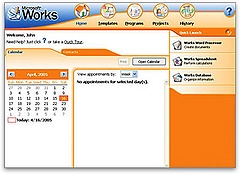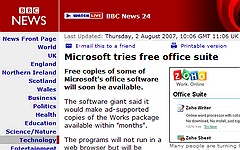The Bug has arrived, It’s going to be big.
That’s the gist of what I can figure from a flurry of blog-posts on the new Open Source Hardware device to be launched soon.
I still don’t know what the Bug is, but it’s already bugging me . How is it that after reading top blogs like Fred Wilson’s, Brad Feld’s, Mashable, I still don’t know what it is? These guys all say it’s going to be Big, but what does it do? At last Dave Winer has some ideas…
. How is it that after reading top blogs like Fred Wilson’s, Brad Feld’s, Mashable, I still don’t know what it is? These guys all say it’s going to be Big, but what does it do? At last Dave Winer has some ideas…
I’m with Henry Blodget on this:
if Bug’s forthcoming product, The Bug, is to become a consumer hit (which is apparently part of the plan), the company first needs to do a better job of explaining what it does.

 I strongly disagree – at least with the “always” part. In the late 80’s Works was my main productivity suite: I was happily crunching numbers, generating charts, including them as well as data from my database in word-processing documents. In other words, I had a perfectly working and lightweight integrated office suite at the time when Word, Excel and Powerpoint were part of a suite only in name, but moving data between them was a major pain. It had to be lightweight: my laptop had 640K memory (that’s K, not MB!) and two 720k floppy drives – no hard-disk at all. Yet it was happily churning away with Works.
I strongly disagree – at least with the “always” part. In the late 80’s Works was my main productivity suite: I was happily crunching numbers, generating charts, including them as well as data from my database in word-processing documents. In other words, I had a perfectly working and lightweight integrated office suite at the time when Word, Excel and Powerpoint were part of a suite only in name, but moving data between them was a major pain. It had to be lightweight: my laptop had 640K memory (that’s K, not MB!) and two 720k floppy drives – no hard-disk at all. Yet it was happily churning away with Works.



 )
)
 ) what’s more, if anyone is interested in not just the party details, but the (mostly) startups demo-ing their ware, there’s hardly a better summary than
) what’s more, if anyone is interested in not just the party details, but the (mostly) startups demo-ing their ware, there’s hardly a better summary than  towards the purchase of new computer equipment.
towards the purchase of new computer equipment.


 NASA is having a certified Bad Hair Day: Sabotage, Drunk Cosmonauts, Theft – what else should we expect?
NASA is having a certified Bad Hair Day: Sabotage, Drunk Cosmonauts, Theft – what else should we expect? ) so I don’t know if this post will make it.
) so I don’t know if this post will make it.



Recent Comments